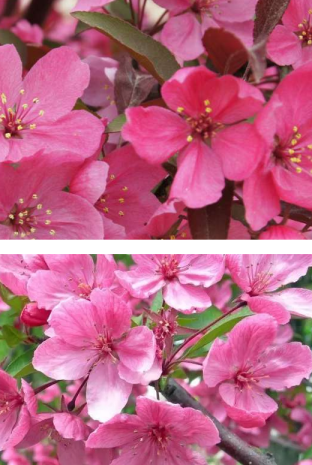Malus “prairie fire” or Prairie Fire Crabapple is a beautiful tree that blooms in the spring with masses of vibrant pink, nearly red flowers. The tree’s fruit attracts numerous species of birds and other wildlife, and its leaves change to vibrant shades of purple, orange, and red in the autumn. This crabapple flourishes in small spaces and possesses several outstanding qualities. It is a small decorative tree that works well in most residential settings with constrained space.
On the other hand, if a person wishes to add a lot of dark pink blossoms to the landscape in the spring, a Show Time Crabapple tree is among the best ornamental trees he or she can own. This Show Time Crabapple tree, also known by its botanical name Malus ‘Shotizam,’ has several beautiful flowers that are as striking as any others early in the season.
Pros
Prairie Fire Crabapples are beautiful additions to practically any garden. These trees are typically 20 feet tall with round branches. They are also great for group planting. In contrast to the surrounding landscape’s greenery, the Prairie Fire Crabapple’s vivid leaves and red bark stand out. The only crabapple that is immune to all crabapple illnesses is this prairie fire variety. The main advantage of this crabapple variety is that it is resistant to apple scab, a common disease. Apple scab is a fungal disease that attacks plants and causes damage to their leaves, blossoms, and finally their fruit. In elder crabapple species, it occurs very frequently.
The Showtime Crabapple tree, on the other hand, has fuchsia-red flowers that glow even brighter than the Prairie Fire flowers. It also has attractive orange fall foliage, which goes well with its brilliant red fruit. This Show Time Crabapple is a year-round beauty, boasting a vibrant display of blooms in springtime and magnificent foliage and berries in the autumn. It blooms in the spring with flowers of a rich fuchsia hue, which lends a sense of drama and visual intrigue to any setting. This medium-sized Show Time Crabapple fits perfectly in most areas and settings. It has an oval form and an upright growth pattern, allowing it to flourish individually or in small clusters.
Cons
The bacterial disease fireblight, which affects trees, is particularly dangerous to the Prairie Fire Crabapple. Symptoms include burnt flower clusters with brown/black, shriveled margins and desiccated, brown tips on young leaf shoots. The infected branch needs to be reduced in length by three to four inches throughout the winter to prevent the infection from spreading.
The Show Time crabapples, like many other crabapples, produce suckers at the base of their trunks. The optimum time to get rid of suckers is during the annual winter pruning, as they damage the plant’s overall form and structure and consume valuable resources.
Showtime Crabapple vs Prairie Fire Growth Rate
The prairies of North America are the natural habitat of the prairie fire crabapple. The little prairie fire crabapple tree has a spreading canopy with a height range of fifteen to twenty feet. The tree bears flowers in the springtime that are either pink or white, and its foliage is a reddish-purple color. Crimson, 1/2-inch fruits are produced by this tree. The edible fruits are typically used to make jam and baked goods.
The Show Time Crabapple, on the other hand, grows twenty to twenty-five feet tall and fifteen to twenty feet wide, which makes it easy to fit into most settings. It grows nicely by itself or in small groups because of its naturally oval form and straight branches.
Showtime Crabapple vs Prairie Fire Care
The Showtime Crabapple can withstand freezing temperatures and is simple to care for. Zones 4-8 are ideal for this Show Time Crabapple. It can withstand freezing temperatures well and does best in soil that is somewhat acidic and well-draining. Full sunshine, or at least six hours of sunlight every day, is ideal to promote the growth of this tree. Additionally, this tree prefers mildly acidic, well-drained, nutrient-rich soils. Show Time Crabapple Trees are best planted in a hole that is twice as broad as the root ball as well as deep enough so that the root flare is at or slightly above the soil level.
Prairifire Crabapples, on the other hand, do best in wet but well-drained places. They can tolerate clay soil if puddles evaporate quickly after rainfall. Create an 18–24-inch berm or mound above the soil to promote drainage. Place the seeds just there on top of the mound. Avoid planting crabapples too deeply in soils with inadequate drainage. Make sure to give the plant a steady flow of water in moderate amounts to help it grow. Winter dormancy is the optimal time for prairie fire pruning.



